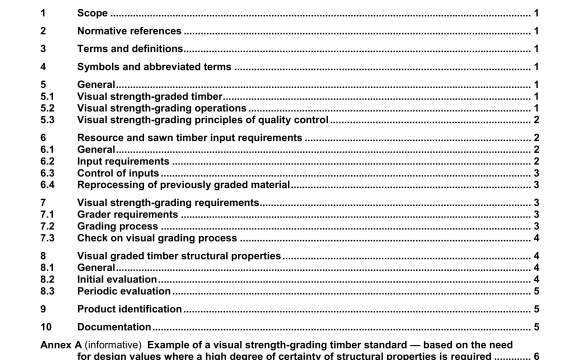ISO 9709 pdf download – Structural timber – Visual strength grading— Basic principles.
7.3 Check on visual grading process
A periodic check shall be required to assess the accuracy of the grading process. If a check mdicates that the process is inadequate, then appropriate measures may be specified to modify the process so that the process is adequate.
8 Visual graded timber structural properties
8.1 General
The oritical properties of strength-graded timber are structural properties. These structural properties may be incorporated in the visual strength-grading standard or may be in other appropriate standards referencing the grades determined using the criteria of the visual strength-grading standard These properties shall be as defined and measured as specified in the test methods In ISO 13910.
The structural design properties shall be determined from tests on timber having a defined moisture content if the tests are conducted on timber having a moisture content that differs from that specified by the procedure confoniiing to this Intemational Standard, the properties resulting frown the tests shall be adjusted (using sound engineering principles) so that the structural design properties reflect the intent of these basic reqLsrements and/or the applicable associated design codes.
8.2 Initial evaluation
Once the gradmg operation has been selected, evidence shall be provided that the resultant output grades have the structural properties stated for the matenal, This evidence may be linked to other mills carrying out equivalent sorting procedures.
For cases where such evidence is not available or It is not appropriate to link me evidence to other mills, an initial test program should be specified. The requirements for this test program should be based on sound sampling principles and the tests for the structural properties shall be based on the test procedures specified ‘in 8.1.
For cases where a high degree of certainty of the structural properties is not required, then the structural properties of the material may be based on other mechanical or physical properties representative of the grade being evaluated providing these properties have been defined and related to me test procedures as specified in 8 1 and continue to be used as the basis of the sorting process.
8.3 Periodic evaluation
Direct measurement of the structural properties of lull-size timber shall be undertaken if there is a reason to expect that the structural properties of visualy graded lumber have changed and may also be specrfied to be undertaken at penodic specified intervals.
9 Product Identification
A product identification mark on the timber shall be specified to indicate the document conforming to this International Standard on which the sorting is based, the grade and/or strength class, and the producer responsible The product identification mark may also indude other information deemed important.
Each piece of timber shall be marked except for high quality strength-graded timber intended for structural as well as appearance purposes For this high quality appearance timber, each shment shall be accompanied by documentation containing the product identification requirements specified in the standard
10 DocumentatIon
Documentation requirements shall include:
a) the standard on which the visual strength-grading process is based;
b) specifications of the resoLace input;
c) specifications of the visual grade sorting process;
d) specifications for the timber grade criteria;
e) methods for assigning and confirming a grade; and
f) specifications for the identification of the product.
Documentation requirements may include:
g) specifications and control checks of the resource input:
h) specifications and control checks of the visual grade sorting process;
i) specifications and control checks of the structural properties;
j) materials identifying the allocation of responsibilities for Quality control operations; and
k) other specifications or materials deemed to be important.
ISO 9709 pdf download – Structural timber – Visual strength grading— Basic principles
